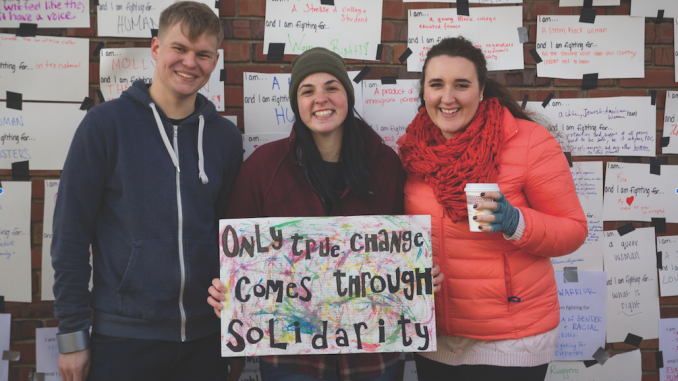
Students, alumni and faculty of SUNY New Paltz decided to take things into their own hands regarding President Donald Trump’s proposed wall for the border between the United States and Mexico this past Monday: by building a “better” wall of their own.
Orchestrated by Deanna Hazelton ‘16 and Jackie Saccente, a fourth-year theater arts major, the “better wall” was built outside of the Humanities classroom building. Inspired by the acts of others marching for civil rights in Washington, D.C., New York, Poughkeepsie and across the nation, the two blossomed this idea to allow students to speak their minds no matter who they are or what they believe in.
“We are trying to get all the students to come together in solidarity to show that we support one another,” Hazelton said. “We all have our own rights that we’re fighting for and we don’t want any voice to be left out. It doesn’t matter what you believe, what you’re fighting for, or who you follow as a leader.”
Their wall was also constructed in large part due to President Trump’s executive order to “ensure the safety and territorial integrity of the United States as well as to ensure that the Nation’s immigration laws are faithfully executed,” effective Wednesday, Jan. 25.
The idea for the “better wall” first stemmed from Saccente, who participated in the Ghostlight Project in New York City on Jan. 19. According to the project’s website, people across time zones gathered outside of theaters at 5:30 p.m. to spread compassion and support for everyone, “regardless of race, class, religion, country of origin, immigration status, (dis)ability, age, gender identity, or sexual orientation.” This is what Hazelton’s and Saccente’s “wall” was all about, too.
“There is a lot of hate and a lot of things that are happening right now that I don’t happen to agree with, and that I know a lot of people don’t agree with,” Hazelton said. “I want them to not be afraid and come out. If you have hate coming toward you right now, it’s OK, we have your back, you have support.”
The “wall building” did not turn out as Hazelton had expected—in a good way—with dozens of students and professors participating in the supportive poster making. Individuals took a piece of paper or poster board that read “I am … and I am fighting for …” and filled in the blanks. Hazelton recounted a poster written by a professor that read, “I am a 53-year-old and I am sick of fighting for the same rights,” alluding to the fact that women have been fighting for equal rights for decades, continuing through today.
Hazelton pointed out other notable posters taped next to each other which read, “I am privileged and I am fighting for equality” and, “I am an immigrant who came here as a baby and I am fighting not to get deported.” Another read, “I am HUMAN and I am fighting HUMANITY!” Juxtaposed placards like these remain with Hazelton, displaying the power of living under different circumstances while still being able to fight for the same cause.
Hazelton and Saccente printed over 60 sheets of paper for those wanting to participate in their cause. Though many took part in this social call for solidarity, there was talk of some wanting to rip down their unifying wall. Sam Doolittle, a fourth-year anthropology major who assisted the girls, speculated that if people wanted others’ voices to be silenced, it must be making a large impact.
“If people want to silence something, that means there must be a really good message behind it,” he said.
Knowing that their wall must inevitably come down anyway, Hazelton and Saccente plan to file all of the posters in a binder to send to local representatives.
“We want to make our voices heard,” Hazelton said.
